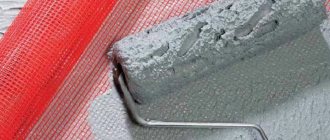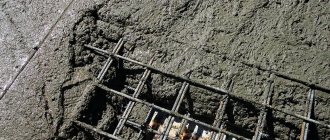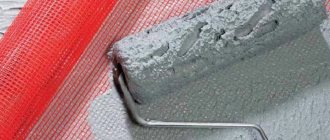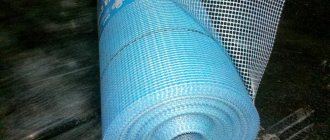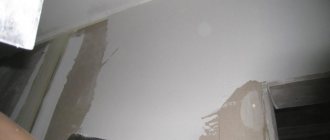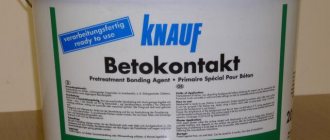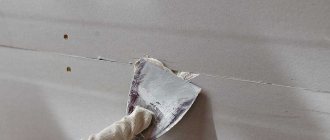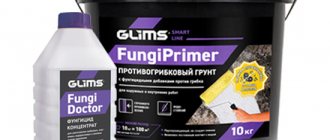Plastering the facade over insulation is used to level the surface of the structure, improve the technical properties of the material and protect it from the negative effects of the environment. Polystyrene foam, which is used for cladding buildings, has good thermal insulation properties, but at the same time it is fragile and short-lived. Mesh for plastering walls is a special building material that is made from various types of reinforcement with different cell sizes.
Purpose of reinforcing materials on the wall for plastering work
Plaster reinforcement is an effective, time-tested technology for improving the characteristics of a leveling coating.
Painting mesh for plaster performs the following functions:
- Helps create a coating layer of greater thickness than specified by the manufacturer. This allows you to solve the problem of uneven walls. Sometimes, to create a uniform and smooth surface, it is necessary to apply more mortar than the structure can withstand.
- Creates conditions for the formation of a solid layer, protects it from shrinkage cracks and their consequences. This is especially important for finishing ceilings, door and window openings. The reinforced mesh helps prevent peeling and subsequent collapse of the finish.
- Increases the durability of the finishing layer. Thanks to the mesh, the coating can withstand heavy loads. For example, this is important if cabinets or heavy shelves for books and other items are mounted on the wall. Thanks to the reinforcing layer, the load on the wall is reduced.
Reinforcement is subject to a solution of any composition whose thickness exceeds 3 cm.
Cases when you need a façade mesh for plaster:
- when performing work with a large thickness of the mixture - partially or over the entire base;
- if the building is located close to other buildings and complexes, which, in turn, have a vibration effect on it;
- if neighboring premises have undergone redevelopment and the specific weight of the structure has been redistributed;
- to modify the initial durability characteristics of the coating - increases the load-bearing capacity for placing attached household equipment and furniture.
Step-by-step instructions for fixing plastic mesh
The durability of its operation largely depends on the correct implementation of recommendations for installing plastic reinforcing mesh on foam insulation. In all cases, do not rush, work carefully. We have already mentioned that there is no need to reinforce the entire wall height; it is enough to protect only the lower vulnerable area. But these are our recommendations; if you have doubts, protect the entire surface of the façade wall.
Fiberglass mesh
Any brand of glue is suitable for gluing the mesh. Study the instructions, it should have high adhesion to plastic materials. In most cases, a finishing layer of adhesive several millimeters thick is applied over the plastic reinforcing mesh. The final coating is done with facade paints or a thin layer of decorative plaster.
Glue for gluing fiberglass mesh to the facade
Step 1. Inspect the surface of the slabs. If they were fixed with dowels, then completely recess the caps and seal the recesses. You can close the gaps at the same time, but this is not necessary. The fact is that the cracks will automatically close during the application of the first layer.
Fastening sheets using umbrella dowels
Step 2. On the wall, draw a horizontal line along the height of the reinforcing layer. It will help you monitor the height of glue application. A thin layer of material dries quickly, and this not only causes an increase in material consumption, but also negatively affects the final leveling of the layer for painting.
Step 3: Prepare the glue according to the manufacturer's instructions. Always pour water into the container first, and then add the dry mixture. This technology will greatly simplify the mixing process. You can mix it manually with a trowel or using a mixing attachment for an electric drill.
Preparation of glue
The second method is not only easier, but also more effective. You need to stir for a few minutes, and then leave the mixture to stand for another 5-6 minutes. During this time, the moisture will be evenly distributed throughout the entire volume, and the smallest dry lumps of glue will completely disappear.
Step 4. The glue is applied to the wall with a spatula; the longer it is, the smoother the resulting surface is. Professionals work with spatulas up to 70 cm in size; beginners can initially use shorter ones.
Practical advice. If you are just learning how to apply glue to a surface, it is better to immediately get used to working with both hands. If one gets tired, use the other hand. Believe me, it is not so difficult, you just need to show a little endurance and patience.
Apply glue to the spatula with a trowel in the center of the tool. The quantity will be determined experimentally. While applying the layer, hold the spatula at an angle to the foam boards and press with medium force. Achieve a layer thickness of approximately 2–3 millimeters. Do not prepare a large amount of surface at once; for beginners, two meters in length is enough. If you do not have time to fix the mesh, the glue will harden, you will have to remove the old layer and make a new one.
Step 5. Try on the location of the plastic reinforcing mesh. If it does not fit into the window opening, trim the material.
Step 6. Glue one end of the mesh, align it horizontally to the length of the prepared section of the wall. Make sure that the mesh lies smoothly without distortions or bends; be guided by a pre-drawn line on the foam.
Practical advice. The mesh should overlap approximately ten centimeters. You may come across recommendations not to apply glue to the overlap of one line, but to do this simultaneously for two rows. We do not recommend doing this, it only complicates the work. Glue the first row of mesh along the entire width at once, including the overlap. The second line will be glued on top of the freshly applied glue. This method simplifies the fixation of the mesh and has a positive effect on quality.
We attach the mesh with overlapping fabrics
Step 7. Use your hand to press the mesh onto the fresh glue in several places and check its position again.
Cut off the excess
How is fiberglass mesh attached to polystyrene foam?
Step 8. Using a spatula, begin to press the mesh to the surface of the insulation. Make sure that the glue of the first layer extends over the entire surface and evenly covers the mesh cells on the front side. If there are areas where the adhesive is not thick enough, reapply it over the reinforcing mesh. Such omissions may appear in inexperienced craftsmen. Over time, you will learn to determine by eye the optimal thickness of the glue and there will be no more gaps. Spread excess solution over free surfaces. You shouldn’t try to immediately make the surface perfectly smooth, but you need to strive for this result.
Gluing the mesh
Gluing the mesh with a spatula
Step 9. Allow time for the glue to dry. It is better to leave it overnight; finishing grouting of surfaces is recommended the next day.
That’s all the technology is, the surface of the façade wall is prepared for painting or finishing with other materials. We remind you once again that plastic reinforcing mesh on insulated facades is not used to prevent cracks on the surface of the adhesive, but to prevent mechanical damage to the foam. Keep this in mind when making your decision.
Prices for popular types of putty
Putties
Types of reinforcing mesh for walls
The mesh for finishing work acts as a frame that holds the entire structure from destruction.
Before using reinforcement, other building materials were also tested. Experts wanted to get strength, high adhesion, elasticity and durability from them. However, not all options survived testing. Special requirements are imposed on materials that are used for exterior finishing, because... Temperature changes, moisture and other climatic factors have a negative impact on the surface.
The following meshes are most often used for plastering facades:
- metal;
- fiberglass;
- polyurethane;
- fiberglass;
- lavsan;
- from modified basalt glass (only for wooden surfaces).
Metal construction reinforced mesh
Iron reinforcing material is produced in various variations. Each modification has its own characteristics and technical features.
Plaster mesh is distinguished according to the following characteristics:
- by weaving method and cell sizes;
- by the thickness of the rods and the method of processing them;
- according to composition and production method.
The advantages of metal reinforcing material include:
- high strength;
- possibility of use with any type of mortar and base (concrete, cement, clay, wood, etc.);
- strengthening effect on a layer of any thickness;
- the ability to cut the canvas with metal scissors or simple wire cutters;
- the ability to withstand foundation shrinkage and vibration from neighboring buildings.
The disadvantages included:
- the heavy weight of the iron sheet, because of this it cannot be used to reinforce thin walls or drywall;
- the ability of uncoated iron to deteriorate due to corrosion.
Metal mesh for reinforcing plaster is divided into several types:
- All metal expanded metal
. For its production, sheet material with a thickness of about 0.4-0.5 mm is used, in which cells are made in a checkerboard pattern. The resulting pattern is then stretched until it reaches a height of 1 mm and a width of 3 mm.
- Cold rope or galvanized
. During the manufacturing process, wires of the same thickness are intertwined. The cells will be in the shape of a rhombus or scales.
- Chainlink
- began to be called so in honor of its inventor Karl Rabitz, who patented it at the end of the 19th century. It is characterized by high strength, because the elements are connected to each other by welding.
Why do you need a basalt mesh?
Plaster with mesh will last longer and help protect the insulation from the negative effects of the environment. Basalt reinforcement appeared relatively recently and in terms of strength and reliability has surpassed fiberglass material, which for a long time occupied a leading position. Basalt reinforced mesh is resistant to ultraviolet rays and alkaline environments, and provides good adhesion to putty and plaster.
Due to its technical properties, it is often used to strengthen the base and load-bearing walls indoors. The width of the canvas is from 0.5 m to 5 m, the cell size is from 5 to 25 mm.
Why do we need fiberglass mesh?
Fiberglass mesh for facades under plaster is durable and elastic. It is obtained by melting aluminoborsilicate glass. The material is sold in rolls 1 m wide and 1 m long. For exterior finishing work, fabric with cells of 2, 5 and 10 mm is most often used.
The positive characteristics of fiberglass mesh include:
- fire resistance;
- light weight;
- resistance to corrosion, rotting and other chemical reactions;
- high strength;
- elasticity;
- Possibility of laying on uneven ground.
The following is considered a disadvantage:
- absorbs a lot of liquid solution;
- glass dust that occurs during work can cause allergies;
- To tension the fabric you need an assistant; you can’t do it yourself;
- high price.
Polymer mounting plaster mesh
If the user does not know which mesh for plaster is suitable, you can consider the polyurethane option. Modern material is qualitatively different from the first types of plastic. With low weight it is characterized by high strength. The polymer fabric is made of polypropylene or polyurethane.
The material has a number of advantages:
- does not require additional fastening to the surface;
- has a low roll weight;
- lightweight and easy to transport and install;
- environmentally friendly for people and the environment;
- resistant to negative weather conditions and vibrations from neighboring buildings;
- Due to moisture resistance, there is no corrosion, rotting or deformation.
Plaster with a polyurethane mesh is not resistant to aggressive chemical reactions. In addition, it is not recommended to apply a finishing layer thicker than 6-7 mm to plastic reinforcement.
Polyurethane products are distinguished according to two parameters:
- cell size and shape;
- density level (the maximum load on the reinforcing layer depends on it).
Polymer facade mesh cells for plaster come in two types:
- square (in the description abbreviated PCF or SQ);
- diamond-shaped (it’s easier to carry out single work with them).
Meshes from popular manufacturers
The Italian concern Tenax produces mesh for plastering walls and other structures. In the product line:
- Armaflex is a biaxially oriented network made of polypropylene for plaster coatings with a thickness of 1-3 cm. Weight 100 g/m2. Withstands tensile load –
- Armatek – plastering fiberglass mesh. Density 110-138 g/m2.
- Polypropylene Sintaflex E can fully replace hardware in terms of strength. It is used for plastering walls up to 7 cm thick, reinforcing concrete screeds, and also for protection against moles.
- Plurima is a polypropylene product with small cells 5x5 mm. The area of the rolled fabric is 250 m2. Roll weight – 10.4 kg. Chemically resistant. Used for thin layers of decorative plaster and brickwork.
All products are universal, chemically inert, resistant to UV rays, and geometrically stable.
As for the plaster facade mesh sheets Valmiera, Alabuga, Bautex Eurofacade, Vertex, Textile Glass, they cannot be used inside the plaster layer, since they do not strengthen, but separate the plaster into two layers. They are used only by placing them inside a reinforcing layer of polymer glue, into which they are embedded.
Experience shows that the mesh for plaster is a very important element that helps prevent the appearance of cracks and destruction of the plaster layer under vibration loads and settlement of the building. It also protects facades covered with thermal insulation from destruction. The correct choice of reinforcing product and adherence to technology guarantee durability and long-term preservation of the appearance of the finish.
Methods of fastening reinforcing sheets for plastering indoor walls and facades
The question of the method of attaching the reinforcement to the wall arises only after the base layer has dried. The strength and durability of the finish depend on the skill of performing the work. The technology of work is selected based on the material of construction and reinforcing material. Failure to comply with this may result in peeling of the leveling and decorative layers from the walls.
The basic rule that experts highlight is that the mesh is tightly adjacent to the wall. There should be no bends, overlaps or folds on it (only highly specialized work is carried out with overlaps). For fastening, plaster compounds, dowels or hardware are used.
A mesh for plaster made of metal or basalt glass is attached to a wooden base with construction staples or screws and only then covered with a finishing layer. Holes for dowels are first drilled on the mineral surface. Their number is determined so that the reinforced mesh is reasonably tensioned and does not sag anywhere. This placement will create additional protection from vibrations.
The fiberglass sheet is simply embedded on the wall in 4-5 mm of plaster mortar. The mixture is applied with a serrated tool.
This will make the process of laying the sheet easier, since an even spatula can damage the reinforcing sheet or stretch it. The leveling layer is applied only after the reinforcement has dried thoroughly.
Question answer
Is it possible to repair peeled areas with façade reinforcement mesh? It is possible, but it is better to avoid such situations. Unfortunately, in most cases, peeling appears several months or years after finishing the insulated façade walls.
Repair of peelings
How is the repair done?
- Inspect the peeled area. Using your hand, check the strength of the mesh fixation next to the detached area. Prepare materials: glue and a piece of plastic reinforcing mesh. If the facade walls are painted, then you need to have the appropriate paint.
- Pull the peeled mesh towards you and use a sharp mounting knife to cut it around the perimeter. Work very carefully, do not damage the foam. If the sect continues to flake off during cutting, great. In this way you remove the entire problem area; in any case, it would peel off over time.
- Cut a new mesh for the patch, the size should be slightly larger than the cleared area for the overlap.
- Remove the layer of old glue from the surface of the foam.
- Using a spatula, carefully remove the top layer of glue from the surface of the remaining mesh to the width of the new overlap. Apply the first layer of glue, embed the mesh into it and apply the second layer of glue.
- After it dries, level it. Pay special attention to the docking area. It should be as smooth as possible without sudden changes in height.
Repair of a peeling area
How does the quality of plastic mesh depend on its price? Almost nothing. When choosing a mesh, pay attention to the thickness of the fabric and the size of the mesh cells. All other characteristics are nothing more than advertising gimmicks of the manufacturers.
Plastic mesh
What is better than a plastic anti-corrosion coating for metal reinforced mesh against galvanizing? Nothing, besides, the price of such a mesh is higher than with galvanized wire. You need to know that the adhesion of all cement mortars to plastics is significantly lower than to galvanized surfaces. As for the service life and load-bearing capacity, these indicators are absolutely identical.
Metal mesh with polymer coating
Is it possible to do without reinforcing mesh when plastering uneven façade walls? Not only is it possible, but it is necessary. We have already talked about simpler and more effective methods of working with such surfaces. Reinforcement with metal mesh is used not to prevent the appearance of cracks, but to increase the bearing capacity of cement-sand mortars. It is needed when screeding the floor. One more nuance. The indicators of linear thermal expansion of metal and solution differ significantly. This means that microcracks will certainly appear in the places where cement and metal mesh meet, because outside temperatures fluctuate within significant limits. In enclosed spaces there are no such fluctuations.
Should I use reinforcing mesh on the basement surfaces of façade walls? Use this technology only for foam-insulated bases. In all other cases it is not needed.
Photo - a cake made of insulation and mesh for reinforcement
How much does the cost of finishing facade walls increase due to the use of reinforcing mesh? The cost of finishing increases by no more than 3–5%. But if we take into account possible repairs due to mechanical damage to the foam, then a slight increase in cost is completely justified.
Technology of plastering walls with reinforcing mesh (indoors and outdoors)
Before applying the finish, the base must be prepared for further work. First of all, damaged areas (for example, eaten away by mold, corrosion or fungus) are eliminated. They are cleaned and treated with special protective solutions. Then apply primer and level the surface. If necessary, glue the insulation, apply a reinforcing mesh for plastering the walls and a finishing layer.
Fastening the mesh using the correct technology
First you need to calculate the amount of canvas that will be required to complete the work. The method of fastening will depend on the type of base and the material itself. In any case, the cellular fabric must be secured strictly according to technology, avoiding strong tension or sagging.
Fastening the reinforced mesh
If lightweight products are easily fixed to the mortar by rubbing it in with a spatula, then thicker, more durable materials need to be fixed more securely. The operating procedure will be as follows:
- measure the required amount of material, carefully cut off a suitable piece;
- Secure it at the top with dowel nails, smooth out the corners and secure with self-tapping screws;
- repeat a similar operation from below, ensuring the optimal degree of tension;
- At the end of the work, attach the material in the middle so that it fits well to the rough base.
Installation of metal mesh under plaster
How to fix a product under a plaster base
Colored and other decorative fabrics are secured with simple self-tapping screws. At first, they are not completely screwed into the base at equal intervals according to the markings. Then put on the mesh and screw the screws into the wall completely. Sagging of the canvas must be completely eliminated! Small pieces of material or temporary coverings can be attached to the foam.
Fastening the mesh for drywall plaster
Coating with polymer sheets
Typically, such canvases are fixed with a mortar and a spatula. Cut the mesh into pieces of the required size, taking into account seam allowances. Apply a layer of plaster, carefully press a piece of material into it, and smooth it with a spatula. The fabric is overlapped so that one strip overlaps the other by 15–20 cm. If the walls have a complex configuration, the fastening is additionally reinforced with staples, screws or dowels.
Plastering walls with polymer canvas
Metal coatings
For a layer of plaster equal to 3–5 cm, a metal mesh is usually used. It weighs quite a lot, so it must be securely fastened. Before starting work, the canvas is degreased to remove dirt and lubricant residues. Traces of rust on carbon steel are treated with an anti-corrosion compound. Cut out pieces of the required size depending on the placement method (crosswise or lengthwise) using metal scissors or a grinder.
In the structure, holes with a diameter of 6 mm and a depth of 3 mm greater than the length of the dowels are drilled using a hammer drill. The approximate distance between the holes is made equal to 25 cm. The mesh is fixed to the wall with an overlap, starting from the top corner, and the edges are fixed with new dowels. The material is not pulled too tightly so that after plastering it can take an optimal position. Afterwards, the plaster is applied in several stages with intermediate drying of the layers.
Fastening the chain link to the wall
Material selection criteria
The main criterion for choosing the material of the façade mesh used is the thickness of the plaster layer. After all, the larger the layer, which means the heavier it will be, the more reliable its adhesion to the base should be:
- In case of significant cracks or destruction of the surface to be plastered, as well as if a layer of plaster of more than 30 mm is required, metal reinforcing materials should be used. Also, their use is indispensable when reinforcing production facilities or facades that have not previously been finished. Metal models for plaster are securely attached to the wall surface. They are able to withstand significant mechanical loads and will not allow the plaster to peel off.
- Plastic, including fiberglass, reinforcing mesh is used for a plaster layer of up to 30 mm. The main function of such a material is to prevent the mortar layer from cracking.
- If a cosmetic finishing layer of less than 20 mm is required, problems may arise with the mesh being completely recessed into the plaster layer. Therefore, with a flat surface without cracks, the use of reinforcement is not necessary.
Advice! You should take a responsible approach to the choice of reinforcing material. This will prevent you from making an excessively thick layer of plaster unnecessarily.
Masonry and plastering
This product is also made by welding pieces of wire laid perpendicular to each other. More often, walls are reinforced with masonry mesh during their construction and floors during screed pouring, although this material is also quite suitable for plastering work.
Plastering metal mesh is designed specifically for plastering work. Made from galvanized wire that has undergone heat treatment. The product is designed for uniform and optimal distribution and retention of the plaster solution, as well as minimizing material loss.
Alternative to plaster mesh
Sometimes we simply cannot use a plastic mesh structure to reinforce the future layer of plaster. In this case, you can try to cope without it - by preparing the wall accordingly. First of all, you should pay attention to treating the wall with a primer, which should increase adhesion. In this case, you can also leave notches on the wall with an ax. Thus, we increase the adhesion of the mortar to the wall. But at the same time, we are unlikely to be able to achieve the same significant results as with the use of mesh, and damage to the plastered surface may appear in the near future.

